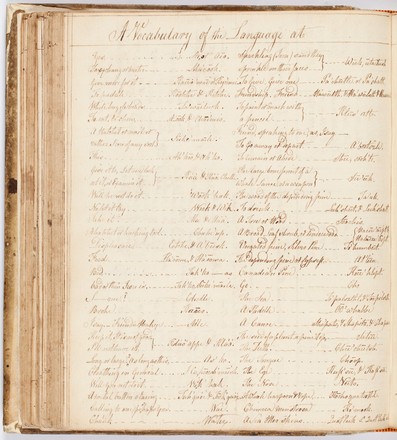A vocabulary of the language at King Georges Sound
from the log and journal of HMS Resolution, 1778
Manuscript
Bequest of Sir William Dixson, 1952
DLMS 98
Cook’s third and final voyage was an attempt to locate the North-West Passage, an ice-free sea route which linked the Atlantic to the Pacific. After a year among the islands of the South Pacific, the expedition sailed north to explore the northwest coast of America to the Arctic Circle. On this part of the voyage, he spent a month in Nootka Sound, also called King George’s Sound, in what is now the Canadian province of British Columbia. While there, he traded with the indigenous Nuu-chah-nulth people, and it is their language which King records in this journal.
James King served as second lieutenant on this voyage. The journal entries pre-date Cook’s death in Hawaii in 1779.
Cook and the South Seas
Cook's three epic voyages to the South Seas, between
1768–79, transformed the way Europeans viewed the Great South Land and the
Pacific Ocean.
James Cook's first Pacific voyage (1768–71)
was aboard the Endeavour and
began on 27 May 1768. Cook's first goal was to establish an observatory at
Tahiti to record the Transit of Venus, when that planet passed between the
earth and the sun on 3 June 1769. The second aim of the expedition was to
record the region’s natural history, led by 25-year-old Joseph Banks. The final
secret goal was to continue the search for the Great South Land.
Although Cook’s Endeavour voyage took possession of Australia
for Great Britain, many still believed that the legendary Great South Land was
yet undiscovered. Despite the achievements of his first voyage, Cook himself
lamented his failure to find the southern continent and pleaded for another
opportunity to seek it. He was promoted commander and given charge of an
expedition, with himself in the Resolution
and Tobias Furneaux captain of the Adventure.
On this second voyage in 1772–75, Cook circumnavigated the world in high
southern latitudes. The chief importance of this voyage for Australian
discovery was in February and March 1773, when the Adventure, parted from the Resolution
by fog and gales, made for the south coast of Van Diemen's Land. Here Furneaux
renamed Adventure Bay on Bruny Island, sailed around Tasman Peninsula and up
the east coast to Flinders Island, but through bad weather failed to reach
Point Hicks before proceeding to rendezvous with the Resolution in New Zealand.
Cook’s
third and final voyage was an attempt to locate the North-West Passage, an
ice-free sea route which linked the Atlantic to the Pacific. Again, Cook
commanded
Resolution while
Charles Clerke commanded
Discovery.
Leaving England in 1776, Cook first sailed south to Tahiti to return Omai, a
Tahitian man, to his home. Omai had been taken on Cook’s second voyage and had
been an object of curiosity in London. Cook then visited Hawaii, becoming the
first European to land there. Sailing north, Cook undertook an unsuccessful
tour along the coast of Alaska to the Arctic Circle in 1778. Cook decided to
return to Hawaii to spend the northern winter, a decision which resulted in his
own tragic death and the deaths of four marines and 17 Hawaiians at Kealakekua
Bay on the island of Hawaii.



 Back to list
Back to list